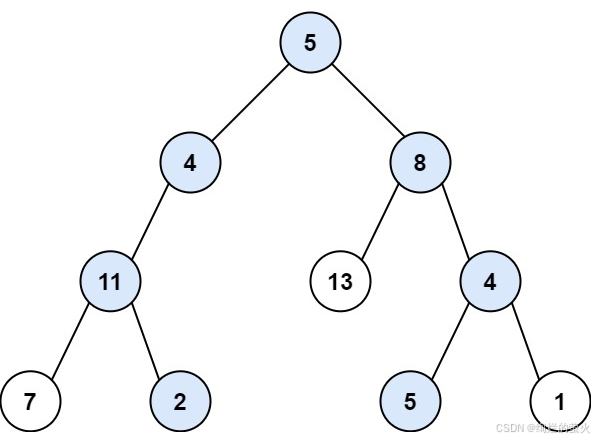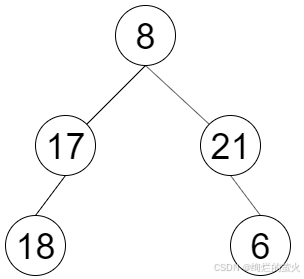二叉树中和为目标值的路径
给你二叉树的根节点 root 和一个整数目标和 targetSum ,找出所有 从根节点到叶子节点 路径总和等于给定目标和的路径。叶子节点 是指没有子节点的节点。
示例 1:

输入:root = [5,4,8,11,null,13,4,7,2,null,null,5,1], targetSum = 22 输出:[[5,4,11,2],[5,8,4,5]]
提示:
- 树中节点总数在范围
[0, 5000]内 -1000 <= Node.val <= 1000-1000 <= targetSum <= 1000
/**
* Definition for a binary tree node.
* public class TreeNode {
* int val;
* TreeNode left;
* TreeNode right;
* TreeNode() {}
* TreeNode(int val) { this.val = val; }
* TreeNode(int val, TreeNode left, TreeNode right) {
* this.val = val;
* this.left = left;
* this.right = right;
* }
* }
*/
class Solution {
List<List<Integer>> ret = new LinkedList<List<Integer>>();
//存储路径的队列
Deque<Integer> path = new LinkedList<Integer>();
public List<List<Integer>> pathSum(TreeNode root, int target) {
//二叉树
dfs(root, target);
return ret;
}
public void dfs(TreeNode root, int target) {
//根节点为空
if (root == null) {
return;
}
path.offerLast(root.val);
target -= root.val;
//子节点为空
if (root.left == null && root.right == null && target == 0) {
ret.add(new LinkedList<Integer>(path));
}
//遍历左子树
dfs(root.left, target);
//遍历右子树
dfs(root.right, target);
path.pollLast();
}
}
彩灯装饰记录I
一棵圣诞树记作根节点为 root 的二叉树,节点值为该位置装饰彩灯的颜色编号。请按照从 左 到 右 的顺序返回每一层彩灯编号。

输入:root = [8,17,21,18,null,null,6] 输出:[8,17,21,18,6]
提示:
节点总数 <= 1000
/**
* Definition for a binary tree node.
* public class TreeNode {
* int val;
* TreeNode left;
* TreeNode right;
* TreeNode(int x) { val = x; }
* }
*/
class Solution {
ArrayList<Integer> a=new ArrayList<Integer>();
public int[] levelOrder(TreeNode root) {
Queue<TreeNode> q=new LinkedList<TreeNode>();
//根节点为空
if(root==null) return new int[0];
//添加根节点
q.add(root);
//当队列中存储的节点不为空时,进行遍历
while(!q.isEmpty()){
TreeNode t=q.poll();
//添加节点的数值
a.add(t.val);
//左边子节点不为空
if(t.left!=null) q.add(t.left);
//右边子节点不为空
if(t.right!=null) q.add(t.right);
}
int[] re= new int[a.size()];
//遍历查询列表中的值
for(int i=0;i<a.size();i++){
re[i]=a.get(i);
}
return re;
}
}验证图书取出顺序
现在图书馆有一堆图书需要放入书架,并且图书馆的书架是一种特殊的数据结构,只能按照 一定 的顺序 放入 和 拿取 书籍。
给定一个表示图书放入顺序的整数序列 putIn,请判断序列 takeOut 是否为按照正确的顺序拿取书籍的操作序列。你可以假设放入书架的所有书籍编号都不相同。
示例 1:
输入:putIn = [6,7,8,9,10,11], takeOut = [9,11,10,8,7,6]
输出:true
解释:我们可以按以下操作放入并拿取书籍: push(6), push(7), push(8), push(9), pop() -> 9, push(10), push(11),pop() -> 11,pop() -> 10, pop() -> 8, pop() -> 7, pop() -> 6
示例 2:
输入:putIn = [6,7,8,9,10,11], takeOut = [11,9,8,10,6,7] 输出:false 解释:6 不能在 7 之前取出。
提示:
0 <= putIn.length == takeOut.length <= 10000 <= putIn[i], takeOut < 1000putIn是takeOut的排列。
class Solution {
public boolean validateStackSequences(int[] pushed, int[] popped) {
//创建栈
Stack<Integer> p1=new Stack<Integer>();
Stack<Integer> p2=new Stack<Integer>();
int pop=0;
for(int i=0;i<pushed.length;i++){
//插入数值
p1.push(pushed[i]);
//只要查询的栈内数值不为空,或栈顶数值与取出的数值不相符时,进行循环
while(!p1.isEmpty()&&popped[pop]==p1.peek()){
//弹出数值
p1.pop();
pop++;
}
}
//根据p1是否为空,判断取出顺序是否一致
return p1.isEmpty();
}
}























 2468
2468

 被折叠的 条评论
为什么被折叠?
被折叠的 条评论
为什么被折叠?










